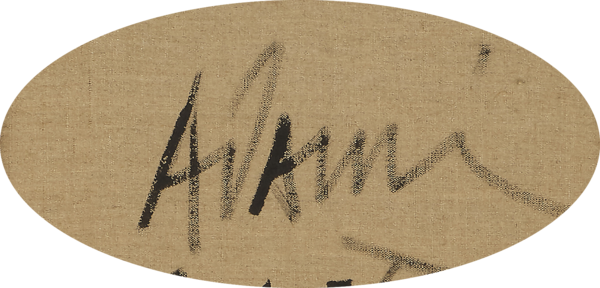

(Born in Bologna, Italy, in 1935)

Valerio Adami was born in Bologna, Italy in 1935. He grew up in a family of artists. His father was a painter, and his mother was a musician. Exposed to art from an early age, he developed an early interest in painting. He studied at the Brera Academy in Milan (1951-1954) and worked as a draughtsman until 1954 in Achille Funi's studio. During this period, he was influenced by the masters of the Italian Renaissance as well as contemporary artists such as Giorgio Morandi and Renato Guttuso. In 1955, he moved to Paris, where he met Roberto Matta and Wifredo Lam. His first solo exhibition took place in 1958. He found his own style in Figuration Narrative. He lives and works in Paris.
Early in his career, Adami explored various artistic techniques, including watercolour and engraving, but eventually found his way to oil painting. His unique style developed in the 1960s, when he began to create figurative compositions with stylised figures and abstract landscapes. Adami's works are often imbued with a complex narrative dimension. His paintings tell stories, often inspired by literature, philosophy and art history. The characters he depicts are often archetypes or symbols, rather than specific individuals, and they are often staged in ambiguous spaces or in non-linear compositions.
Valerio Adami also draws inspiration from photographs of documents cut out from newspapers; he constructs and reconstructs a pictorial world in which "awareness" can only be achieved through a psychoanalytical reading. He "delves into all those associations [...] Freudian and free, which precede form". In his paintings, black lines divide and encircle fields of flat, solid colours, sometimes almost fluorescent, sometimes pastel. He fragments volumes with great precision. The drawing divides the image into geometric surfaces. He develops a psychological pictorial style characterised by elaborate drawings, which colour serves to divert, modify or amplify. His works are characterised by the saturation of the coloured surfaces where there is no white, no trace of doubt or incompleteness.
Since the late 1960s, he has worked mainly on portraits, ironic or poetic tributes to artists or writers who fill his world with mental references: "To represent an idea is an ideal". His paintings are titled: Henri Matisse travaillant à un carnet de croquis (1967), Sigmund Freud en voyage vers Londres (1973) or Portrait de Pierre Boulez (1988). During the 1970s, Valerio Adami established himself as one of the most emblematic representatives of New Figuration. At the end of the 1980s, Adami executed large-scale murals for various public buildings: notably in 1973-1974 for the First National City Bank in Madison and in 1989 for the foyer-bar of the Théâtre du Châtelet in Paris. In 1985 he took part in the Paris Biennale. He also created eight stained glass windows for the town hall in Vitry-sur-Seine (1985) and monumental paintings for the Salle des Pas perdus in the Gare d'Austerlitz in Paris (1992). In 1993-1994, he also created four monumental paintings for the Park Tower Hotel in Tokyo, designed by the Japanese architect Kenzo Tange.
Adami's art has been widely exhibited throughout the world. He has taken part in many group exhibitions and has had numerous solo shows in renowned galleries and museums. His work is part of the permanent collections of major museums, including the Museum of Modern Art in New York, the Centre Pompidou in Paris and the Uffizi Gallery in Florence. Throughout his career, Valerio Adami has been recognised and rewarded for his outstanding contribution to contemporary art. He has received numerous awards and distinctions, including the Lissone Prize in 1962 and the Marzotto Prize in 1970. His work continues to influence and inspire many artists and art lovers around the world. Valerio Adami is a major figure in Italian contemporary art, whose works are appreciated for their distinctive aesthetic and intellectual content. His unique style and ability to fuse abstraction and figuration have made him one of the most remarkable artists of his generation.